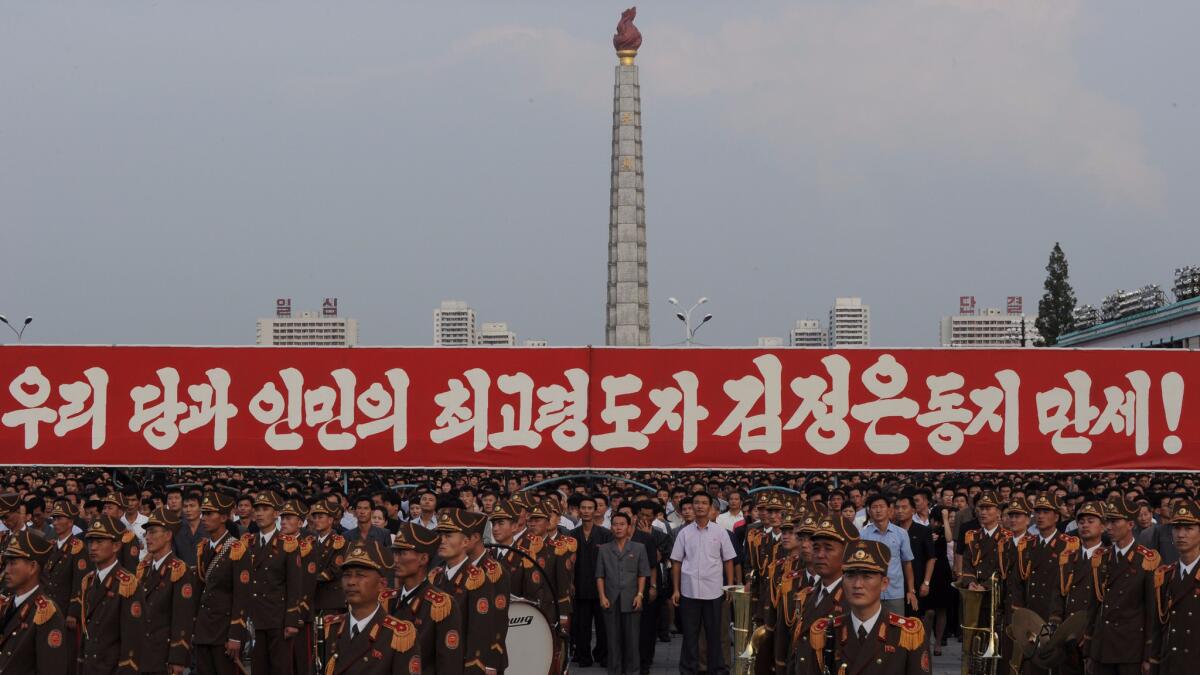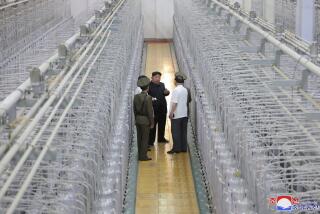The Cold War saw decades of nuclear deterrence. What happens when a rogue state gets the bomb?

Reporting from Washington â Barely a week after North Korea exploded the most powerful nuclear device it has ever tested, U.S. defense officials said the secretive country appears to be readying a tunnel for yet another, putting the country on an alarmingly fast-paced schedule to deploy nuclear warheads.
The preparations for what would be its third test this year reinforce growing concern that North Korea may soon have multi-stage ballistic missiles that could threaten much of Asia and, possibly within a decade, an intercontinental ballistic missile that could reach the U.S.
Pyongyangâs aggressive testing program, in defiance of tough international sanctions, has set off an urgent debate about the risks of a nuclear-armed North Korea and raised questions about whether the policies of deterrence honed over six decades of nuclear confrontation apply to a nation that operates outside international norms of behavior.
âIn theory, deterrence works if your adversary is rational, but if it is a crazy person they wonât care,â said Philip Coyle, a U.S. nuclear weapons scientist who recently was a security advisor to the Obama administration. âIt is the reason everybody is so worried about them getting weapons.â
Former Defense Secretary William Perry said he is concerned not that North Korea would start a nuclear war, but that having nuclear weapons could make the unpredictable nation more willing to launch a conventional war that could progress into a nuclear exchange.
âThe danger is that they might blunder into a nuclear war by miscalculation, not a war by plan,â he said.
In the Cold War, the U.S. and the former Soviet Union each deployed tens of thousands of nuclear bombs that could level every major city and every critical industrial asset of both countries â a potential so devastating that it discredited the idea of victory or even survival after a nuclear war.
But while the two Cold War superpowers could be counted on to act rationally, North Korea exists in social isolation. Its economy is failing, and its most critical mission is the preservation of the government of Kim Jong Un and the several thousand privileged Communist Party officials who support him.
The U.S. should âabsolutelyâ be worried that Kim could eventually launch an unprovoked attack on the U.S. if he ever gains ICBMs with enough range to reach across the Pacific, said Bruce Bennett, a Rand Corp. expert on North Korea.
âRegime survival is their top priority,â Bennett said. âUnless you threaten Kim directly, it will be difficult to deter them.â
As North Korea progresses in its nuclear program, it is fomenting political discussion in both Japan and South Korea about their own potential nuclear weapons development. If either nation develops a capability, it will likely lead the other to follow and encourage China to expand its own program, thereby setting off an Asian nuclear arms race.
With each passing year, there are fewer diplomatic levers available to pressure the government in Pyongyang.
The Washington-based Council on Foreign Relations in a report Friday found that the current U.S. policy of âstrategic patienceâ with North Korea neither stops the nationâs provocative acts nor ensures the safety of its neighbors.
It describes a âdeteriorating positionâ in which the U.S. must act quickly and pressure China to help.
âAs North Koreaâs nuclear capabilities have grown, multilateral negotiations aimed at securing a denuclearized peninsula have ground to a halt,â according to the report, led by Michael G. Mullen, retired Navy admiral and former chairman of the Joint Chiefs of Staff, and Sam Nunn, former chairman of the Senate Armed Services Committee.
Under three generations of Kim family leadership, North Korea has created an extraordinary militaristic culture, devoting an estimated 40% of its government spending on defense. It has built thousands of underground military installations, including an air base that has an underground runway with an opening for planes to fly out.
Kim Jong Un, despite his youth, has ruled with both brutal power and erratic behavior. In 2013, he ordered his uncle machine-gunned in front of hundreds of officials and then had the body incinerated with flamethrowers. Kimâs father, Kim Jong Il, once proclaimed that a military defeat of North Korea would merit the destruction of Earth.
The country has a long history of aggression that includes the bombing of a civilian airliner in 1987, the sinking of a South Korean warship in 2010 and an artillery barrage on South Korea just last year.
Earlier nuclear tests by North Korea were seen as attempts to leverage for more aid and sanctions relief. However, analysts inside and outside the government agree that Pyongyangâs nuclear strike capability has steadily improved to such an extent that it can no longer be ignored.
North Korean officials claim they have already developed miniaturized nuclear weapons that they can mass produce, a claim that has not been disproved or even disputed by U.S. experts.
U.S. spy satellites have detected some activity at North Koreaâs Punggye-ri underground facilities, possibly indicating preparations for another test, U.S. officials said. South Korean media reported this week that Pyongyang is planning to conduct yet another test.
Experts said further tests would suggest that North Korea has an ample supply of plutonium, which when coupled with its unknown stockpile of highly enriched uranium is enough to make additional warheads, despite more than a decadeâs worth of tightened international sanctions.
Several years ago, American intelligence agencies concluded that North Korea probably had enough plutonium for two or three bombs. Its current stockpile would be enough for about 20 nuclear weapons with more on the way, said Jeffrey Lewis, a nuclear weapons analyst with the James Martin Center for Nonproliferation Studies in Monterey.
âThereâs no deterring them,â he said. âEven if the U.S. got rid of all of their nuclear weapons tomorrow, it wouldnât change a thing.â
There’s no deterring them. Even if the U.S. got rid of all of their nuclear weapons tomorrow, it wouldn’t change a thing.
— Jeffrey Lewis, nuclear weapons analyst
On Tuesday, two U.S. B-1 supersonic bombers conducted a low-level flight with South Korean fighter jets near Osan, South Korea as a response to last weekâs nuclear test. The U.S. is deploying a new missile defense system in South Korea. The U.S. has also deployed ballistic missile defense systems in Alaska and California, though their reliability is in dispute.
Meanwhile, South Korea has invested heavily in what it calls its âkill chain,â a system of conventional missiles designed to deny North Korea first use of nuclear weapons. And the U.S. no doubt has enough conventional weapons to destroy North Korea without ever resorting to nuclear bombs.
The vastly more advanced conventional military forces facing North Korea paradoxically could increase its incentives to use nuclear weapons first in a crisis or a conventional conflict, said Kingston Reif, an analyst with the Arms Control Assn. in Washington.
âIndeed, the trajectory of North Koreaâs nuclear and missile development suggests that Kim Jong Un seeks the capability to use nuclear weapons in this way in the hopes of preventing the United States and South Korea from pressing its conventional advantage,â he said. âSo we have a very messy and difficult problem on our hands, and one that South Korea especially and understandably finds increasingly intolerable.â
Further complicating U.S. deterrence strategy with North Korea is a complete absence of diplomatic relations. Even amid the most contentious points in the Cold War, the U.S. and the Soviet Union maintained embassies.
The only outlet for the U.S. to communicate to Pyongyang is through China because North Korea is an impoverished country that relies on China for much of its food and foreign aid.
But North Korea harbors deep historic resentments toward China, said James Person, a North Korea expert at the Wilson Center. Exerting pressure on North Korea through China is unlikely to get the U.S. any results, he said. Person believes North Koreaâs nuclear program is based on a single goal of defending the nationâs sovereignty against not only the U.S. but also China and Japan. It is a policy underpinned by deep insecurity, though it is not without logic, he said.
Perry, the former Defense secretary, is among those dismissing the idea that the country is suicidal. âI do not believe they are irrational,â he said. âThey have a logic and a calculus that is different than ours.â
The increasing threat by North Korea could prompt calls for new weapons designs or renewed production in the U.S., said Coyle, the former nuclear weapons scientist. Rather than continuing negotiations with a coalition of five other nations, the U.S. should hold direct talks with the Kim regime that could more clearly set down U.S. strategy, he added.
Bennett, the Rand expert, said the most important immediate step is to stop the nuclear testing program, because it would deny North Korea the validation that its research is on the right track and deny Kim boasting power that he has made North Korea powerful.
Hennigan reported from Washington and Vartabedian from Los Angeles.
[email protected] | Twitter: @RVartabedian
[email protected] | Twitter: @wjhenn
ALSO
North Koreaâs deadly floods undermine the nationâs projection of power
North Koreaâs latest nuclear test could be a key step in its weapons program
More to Read
Sign up for Essential California
The most important California stories and recommendations in your inbox every morning.
You may occasionally receive promotional content from the Los Angeles Times.












